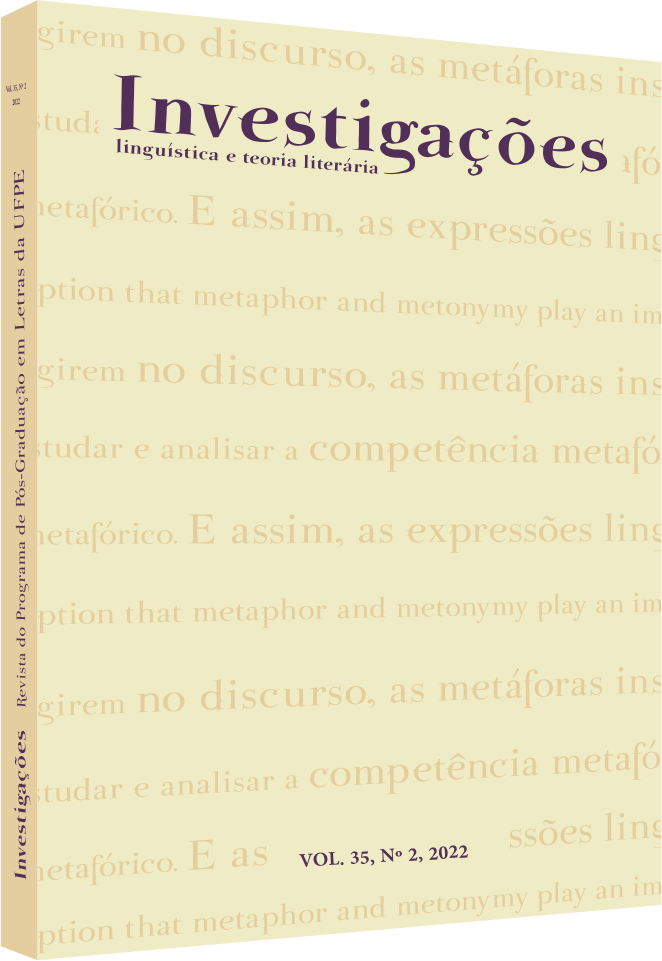Nomeação e exposição midiática
DOI:
https://doi.org/10.51359/2175-294x.2022.253485Keywords:
anthroponymy, media, socioanthroponomistics.Abstract
Thisstudy fits into the field of Onomastics and aims to contribute to the investigation of the motivations for choosing personal names. It seeks to analyze the relationship between the media and the nominator's choices. For this, six first names of celebrities were selected and compared with data from the IBGE, in order to verify coincidences in the frequency of these names. This study seeks to reveal the possible perception of the nominator in relation to the anthroponym based on the sociocultural aspects observed and is of a qualiqualitative nature. The research confirms the hypothesis that there is a relationship between media exposure and anthroponymic motivation.References
AGUIAR, Ronaldo Conde. Almanaque da Rádio Nacional. Rio de Janeiro: Casa da Palavra, 2007.
AMARAL, Eduardo Tadeu Roque. SEIDE, Márcia Sipavicius. Nomes próprios de pessoas: introdução à antroponímia brasileira. São Paulo: Blucher, 2020.
ANTUNES, Irandé. Língua, texto e ensino: outra escola possível. São Paulo: Parábola Editorial, 2009.
CABRAL, Sérgio. A rádio nacional. Revista Textos do Brasil, n°. 11, p. 85-89, 2005.
CALABRE, Lia. A era do rádio. Rio de Janeiro: Jorge Zaar Ed., 2002.
CARVALHINHOS, Patrícia de Jesus. As origens dos nomes de pessoas. Domínios
de Lingu@gem, Uberlândia, v.1, n. 1, 2007.
CORACINI, Maria. José. A celebração do outro: arquivo, memória e identidade: línguas (materna e estrangeira), plurilinguismo e tradução. Campinas: Mercado de Letras, 2007.
DICK, Maria Vicentina Paula. Amaral. Toponímia e antroponímia no Brasil. São Paulo: Coletânea de Estudos, 1990.
GUEDES, Simone Lahud. O Salvador da Pátria: Considerações em torno da imagem do jogador Romário na Copa do Mundo de 1994. Pesquisa de campo – Revista do Núcleo de Sociologia do Futebol, Rio de Janeiro, n. 1, p. 23-41,1995.
GUÉRIOS, Rosário Farâni Mansur. Dicionário etimológico de nomes e sobrenomes. São Paulo: Editora do Brasil, 1949.
HAMBURGER, Esther. O Brasil antenado: a sociedade da novela. Rio de Janeiro: Jorge Zaar Ed., 2005.
HJARVARD, Stig. Miditiazação: teorizando a mídia como agente de mudança social e cultural. Matrizes, [s. l.], v. 5, n. 2, p. 53-91, 2012.
IBGE. Instituto Brasileiro de Geografia e Estatística. Disponível em: <https://censo2010.ibge.gov.br/nomes/#/search>. Acesso em: 19 abr. 2021
LOPES, M. I. V. Telenovela brasileira: uma narrativa sobre a nação. Revista Comunicação & Educação, São Paulo, v. 1, n. 26, p. 17-34, 2003.
MARTINS, Rafael Barbosa Fialho. Sílvio Santos no rádio: uma história a ser contada. Revista brasileira de história da mídia, [s. l.], v. 6, n. 2, p. 171-186, 2017.
MATOS, Cláudia Neiva. CAMP? CAUBY! Entre o conceito e o encanto. Matraga, Rio de janeiro, v. 27, n. 49, p. 156-188, 2020.
MIRA, Maria Celeste. Circo Eletrônico: Sílvio Santos e o SBT. São Paulo: Loyola, 1994.
MURAD, Maurício. Um ícone chamado Pelé. Caravelle, n° 98, p. 1871-182, 2012. Disponível em: <https://journals.openedition.org/caravelle/1226>. Acesso em: 29 abr. 2021.
SAVENHAGO, Igor José Siquieri. Futebol na TV: evolução tecnológica e linguagem de espetáculo. Verso e Reverso, São Paulo, n. 15, p. 22-31, 2011.
SEIDE, Márcia Sipavicius. Métodos de pesquisa em Antroponomástica. Domínios de Lingu@gem, Uberlândia, v. 10, p. 1146-1171, 2016.
SEIDE, Márcia Sipavicius. Motivações contemporâneas para a escolha do antropônimo. EntreLetras, Araguaína, v. 4, n.2, p. 90-101, 2013.
Downloads
Published
How to Cite
Issue
Section
License
Copyright (c) 2022 Lidiane Silva Araújo Guimarães, Vanessa Regina Duarte Xavier

This work is licensed under a Creative Commons Attribution 4.0 International License.
Authors who publish with Revista Investigações agree to the following terms:
Authors retain copyright and grant the journal right of first publication with the work simultaneously licensed under the Creative Commons Attribution 4.0 International (CC BY 4.0) license that allows others to share the work with an acknowledgement of the work's authorship and initial publication in this journal.
Authors are able to enter into separate, additional contractual arrangements for the non-exclusive distribution of the journal's published version of the work (e.g., post it to an institutional repository or publish it in a book), with an acknowledgement of its initial publication in this journal.
You are free to:
Share — copy and redistribute the material in any medium or format for any purpose, even commercially.
Adapt — remix, transform, and build upon the material for any purpose, even commercially.
The licensor cannot revoke these freedoms as long as you follow the license terms.
Under the following terms:
Attribution — You must give appropriate credit , provide a link to the license, and indicate if changes were made . You may do so in any reasonable manner, but not in any way that suggests the licensor endorses you or your use.
No additional restrictions — You may not apply legal terms or technological measures that legally restrict others from doing anything the license permits.

